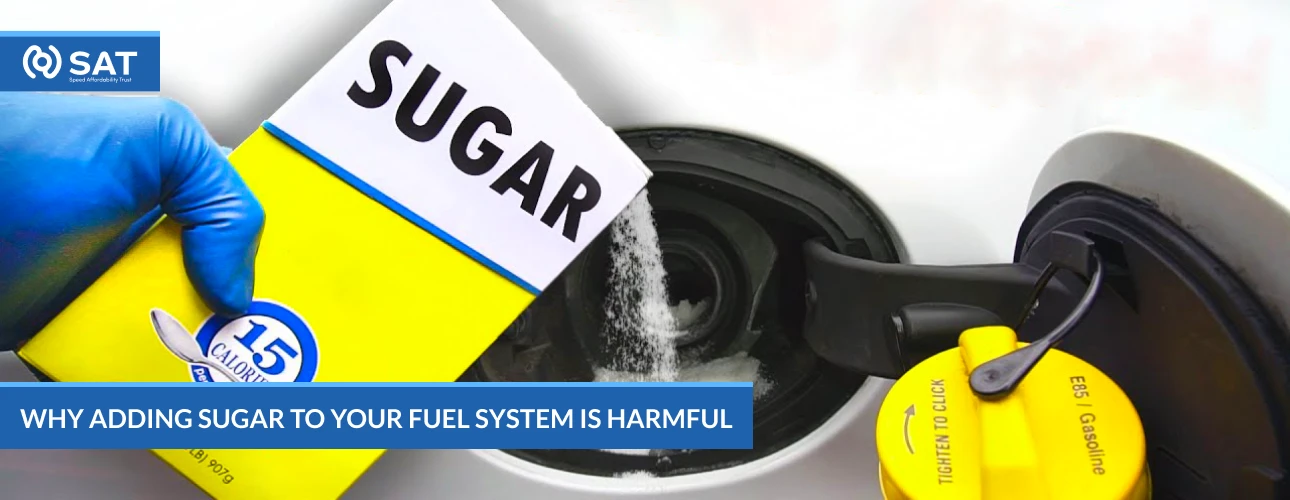The old wives’ tale still holds today and is passed from person to person or on the internet: sugar in fuel system is a surefire method to destroy the engine. That sugar is said to cause an engine to seize, thereby running up a huge bill in repair costs. While perhaps exaggerated in some stories by the full overall damage that sugar can inflict, the fact still remains that sugar in a fuel system is not good at all and really can be a problem for your vehicle. This article discusses why it is dangerous to put sugar into a fuel system, the effects it can have, and how these are managed and prevented.
What Happens When You Put Sugar in the Fuel System?
There are a number of possible problem scenarios that can arise when sugar enters a vehicle’s fuel system, even if it doesn’t dissolve.
The points below explain the sugar in fuel-related damages that may occur:
Filter in fuel:
The fuel filter is the first line of defense to keep contaminants from an engine. When sugar is poured into a vehicle’s fuel tank, it goes to the bottom or is drawn by the fuel. The fuel filter may allow the sugar particles to accumulate to a point where it will cause clogging. The fuel filter clogs limit the fuel flow to the engine, therefore, the poor performance of the engine, runs erratically, stalls, and in some cases fails to start.
Damage Due to Fuel Injectors:
If sugar bypasses or outshines the fuel filter, it then proceeds to the fuel injectors. Being the constituent wherein fuel is sprayed into the engine’s combustion chamber as a fine mist, it may be trapped in the nozzles of the injector; hence, the fuel fails to be delivered in the appropriate manner which it actually should have done. This could manifest in rough idle, misfires, low mileage, and high emissions. Sugar also eats through the injectors over the course of time, and this eventually leads to expensive repairs or replacements. Dangers of Salt in Your Gas Tank can also cause similar issues, leading to severe damage and costly repairs.
Fuel Pump Strain:
A fuel pump circulates gasoline from the fuel tank to the engine. Should sugar clog the fuel filter or the fuel injectors, the fuel pump gets overwhelmed with an increased strain to deliver enough fuel volume and pressure. This takes place from the working of the fuel pump into overdrive to keep up with the desired fuel pressure in the engine. The put-on strain inclines causing overheating or shortening the life of the fuel pump, which amounts to even more problems, in other situations leading to a breakdown.
Contaminated fuel:
But what is likely to occur is that when small granules of sugar are added to the gasoline, they will adulterate it. Thus, the combustible quality of the fuel is lost, and the under-combustion will lead to a decreasing engine power, which again will result in a greater concentration of carbon within the engine. All this might eventually lead to irreparable damage to parts of your engine, such as pistons, valves, and spark plugs, over time. Bleach Can Destroy Your Car Engine if similar substances are introduced, leading to similar detrimental effects.
Engine Hiccups:
By and large, sugar can promptly cause numerous performance problems that are likely related to the fuel system. Common symptoms include hiccups or failure of the start-up process, ill running, general lack of power, poor acceleration, and increased fuel consumption. If not rectified, this will result in serious and more expensive damage to the engine, up to and including a new or replacement engine.
Sugar in Fuel System – The Myth and Reality
The Myth
The most common theory is that sugar, when spilled in a fuel tank, reacts with gasoline to form a thick, sticky paste that then gets trapped within the fuel system and the engine then goes to waste. This is the same situation that has been used in most movies and television.
In fact, it does not at all dissolve in gasoline. Rather, it stays a solid that can continue causing mayhem in the fuel system. The particles of sugar are quite capable of plugging up the fuel filter, fuel injectors, and generally everything else in that passageway, causing performance problems or potentially even damage.
Why Would Someone Pour Sugar Down Your Fuel System?
Ordinarily, pouring sugar down your fuel system would be one of those things that come to mind when you think of sabotage or vandalism. It is a pretty rare practice, but it does pay to know the risks and what someone might want to achieve with such an act. Additionally, it’s crucial to be aware of how Water Enters your Gas Tank and its potential impact on your engine.
Vandalism:
Vandalism is most likely the only intentional act to pour sugar into a fuel system. Someone can do it just out of anger, revenge, or wishing for bad luck in life to sabotage the vehicle and bring trouble to the owner. The act can raise the quantity to be dumped into the vehicle and demand a very large amount as reparation for the victim.
Prank:
Sometimes, people put sugar in a fuel tank as a practical joke out of their ignorance of the possible outcomes. They had no intention to start a fire, but the outcome is that they created damages to property and finances, which they have to spend on repairs unnecessarily.
Misinformation:
There is an awful lot of myth surrounding this and the use of some unconventional substances to solve automobile problems might involve adding sugar to the gas tank to clear out the fuel system or solve some other related problem. In reality, it does not really, only it adds significantly to the problem it is supposed to cure. The Worst Liquid to Put in Car Gas Tank is not a mere myth but a serious issue that can damage your vehicle.
Avoiding and Dealing With Sugar in Fuel
Prevention:
In this respect, however, the best way to prevent a vulnerability from adding sugar—or some other potentially harmful substance—into the training system is to apply good security in the first place. Always park your car in a safe, secure location—a garage, or a well-lit area with surveillance. Also, consider fitting a locking gas cap to stop an unlocked fuel tank. Vigilance and being alert to what is going on around the vehicle might also thwart vandalism of that type.
Diagnosing What has Happened:
If you have a true feeling that sugar has been added to the fuel system, then you would like to cause any symptoms as quickly as possible. That could be as minor as anything wrong from a hard time cranking your engine, to rough idling, to slow acceleration, to even some sudden noises, or even worse yet just sudden poor fuel mileage. If at all any of these symptoms appear, save your car with immediate necessary action.
What To Do If Someone Pours Sugar in Fuel System
Don’t Start the Engine:
If you suspect that someone has poured sugar into your gas tank, don’t start the ignition. When you crank your engine, it provides sugar with a better opportunity to travel through the fuel system, thus causing more damage. It would be best if you had the vehicle towed to an expert mechanic for an expert opinion. You stand the risk of damaging the fuel filter, injectors, and pump system. For more information, read about the Impact of Coke On Your Car Engines.
Have The System Cleaned:
Sugar contamination in the fuel system is reportedly cleaned and inspected comprehensively. The mechanic may also be required to remove the gas tank and flush the same, besides cleaning or replacing the fuel filter and injectors as necessary.
Replace The System:
At times, the fuel pump also has to be replaced, depending on whether the same has suffered wear loss by pushing the fuel throughout the clogged system. The repairs in such times become quite expensive, but they should be undertaken as the only way the car is going to begin functioning properly.
The Cost of the Repair
How much it costs to repair a vehicle with sugar added depends on what damage has been done by the added sugar. At worst, you may need only to drain and clean your fuel tank, a procedure that costs $200 to $500. At worst, you may need to change the fuel filter and injectors, which may drive the price up over $1,000 or even more. If there’s really bad engine damage, the cost of repair will easily top several thousand dollars.
Stay Safe and Sugar-Free
While this myth isn’t completely true—that sugar blends with gasoline and changes to some type of syrup that’s caustic—sugar in the fuel system does cause significant damage. The potential hazards range from clogged filters and ruined injectors to contaminated fuel, engine performance issues, and expensive repairs. Added sugar, whether vandalism, a prank, or even an ill-advised attempt to correct some sort of problem with the fuel system, really is a bad idea. SAT Japan understands these risks and offers solutions to prevent such issues.
That’s where prevention measures come in vehicle security and knowing the symptoms of contamination can ensure that your car won’t be targeted for this type of sabotage. If you truly feel that sugar has gotten into your fuel system, it is time to act extremely quickly to get professional help—this may prevent further damage and even more expensive repairs.




